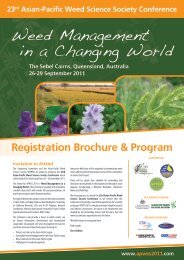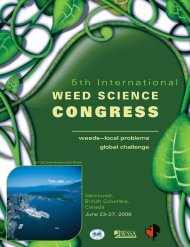PARAQUAT
PARAQUAT
PARAQUAT
You also want an ePaper? Increase the reach of your titles
YUMPU automatically turns print PDFs into web optimized ePapers that Google loves.
pigs have been accidentally or intentionally<br />
poisoned by paraquat (Philbey et al 2001).<br />
• In the UK there have been numerous<br />
poisonings; for example in 2001 there were<br />
6 intentional poisonings of dogs and one of<br />
a cat (Barnett et al 2002); and in 2006 dogs,<br />
hares, a cat, and a fox were affected (Barnett<br />
et al 2007). There were two incidents, in 1976<br />
and 1990, in which 70-80 hares were killed<br />
following the spraying of paraquat on grass<br />
(ERMANZ undated).<br />
5. Environmental Fate<br />
5.1 Soil<br />
Paraquat is very persistent in soil (US EPA 2009).<br />
It binds readily to both clay and organic matter,<br />
with adsorption increasing with clay content. The<br />
soil K oc (sorption coeffi cient) ranges from 8,400<br />
to 40,000,000 (EC 2003).<br />
Paraquat is assumed to be strongly adsorbed to<br />
clay particles, however the US EPA (2009) notes<br />
that “the potential for desorption does exist”. In<br />
Thailand, 5.83% desorption was found in sandy<br />
loam soils (only 0.17% in clay soils) (Amondham<br />
et al 2006). A trial using vineyard soils in Spain<br />
found 70-90% of paraquat was adsorbed, but<br />
11% was desorbed again (Pateiro-Moure et al<br />
2010).<br />
Adsorption increases with increasing pH, and<br />
decreases with increasing acidity (Muhamad et<br />
al 2010).<br />
In highly organic soils, adsorption is weaker<br />
and paraquat remains herbicidally active for<br />
longer, up to 29 days in one trial on soils with<br />
98% organic matter (IPCS 1984). Certain clay<br />
minerals also adsorb paraquat less strongly.<br />
For example in kaolinite clay the paraquat<br />
slowly became available to plant roots and killed<br />
cucumber seedlings, whereas in soil with 1%<br />
montmorillonite it was not available. At the same<br />
time adsorption of paraquat onto clay minerals<br />
affects their capacity for holding water and<br />
nutrients (Weber & Scott 1966).<br />
The strong adherence to soil limits the availability<br />
of paraquat to plants or other organisms; hence<br />
it is very slowly biodegraded. According to<br />
the US EPA (2009), it is resistant to microbial<br />
degradation under both aerobic and anaerobic<br />
conditions: no microbial degradation was seen<br />
after 180 days of aerobic incubation or after 60<br />
days of anaerobic incubation following a 30 day<br />
aerobic incubation. However other authors report<br />
that paraquat can be signifi cantly degraded by<br />
bacteria, fungi, actinomyces and yeast, using<br />
the paraquat as a nitrogen source (Amondham<br />
et al 2006).<br />
Paraquat does not photodegrade, even when<br />
exposed to natural sunlight for 85 weeks,<br />
according to the US EPA (1997). However<br />
Amondham et al (2006) claim that it does, and<br />
Eisler (1990) states that 50% of paraquat in<br />
the surface soils photodecomposes in 3 weeks<br />
whilst that in subsurface soils does not.<br />
Field studies have found a half-life (DT 50 ) of 7-8<br />
years in the UK and 10-20 years in the USA.<br />
DT 90 values (i.e. 90% degradation) were never<br />
reached. Monitoring for residues in the soil in<br />
Europe found residues of between




